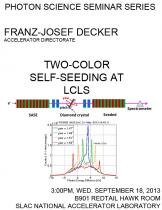Franz-Josef Decker, Accelerator Directorate
The Linac Coherent Light Source (LCLS) produces typically SASE FEL pulses with intensities of up to 5 mJ and at high photon energy an FEL bandwidth 0.2% (FWHM). Self-seeding with a diamond crystal reduces the bandwidth by a factor of 10 to 40. The range depends on which Bragg reflection is used, or the special setup of the electron beam like over-compression. The peak intensity level is lower by a factor of only five, giving the seeded beam an advantage of about 2.5 in average intensity over the use of a monochromator with SASE.
At certain energies and crystal angles different Bragg lines cross which allows seeding at two or even three different colors inside the bandwidth of the SASE pulse. Out-of plane lines come in pairs, like [1 -1 1] and [-1 1 1], which can be split by adjusting the yaw angle of the crystal, allowing two-color seeding for all energies above 4.83 keV.





